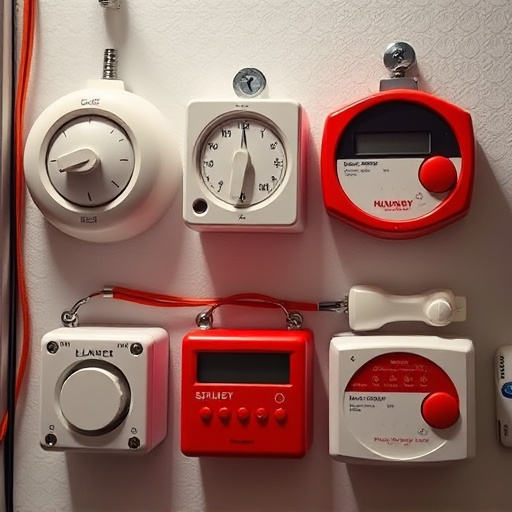Panic alarms offer crucial safety for solo travelers, leveraging powerful sound to deter threats and attract help up to 200m+ distances. Choose based on carry distance needs—urban areas need less range than remote locations. Integrate GPS tools for instant distress signals and location sharing. Test activation sequences, alarm intensity, and charges before travel for peace of mind.
Solo travel can be an exhilarating experience, but ensuring your safety is paramount. An essential tool for peace of mind while exploring alone is an electronic safety device, particularly a panic alarm. This article delves into the significance of these devices, focusing on how far your panic alarm’s sound should carry to ensure effective help arrival. We provide a comprehensive list of essential safety devices and guide you in understanding range considerations, personal safety features, testing, and preparation tips for maximizing carrying distance.
- Understanding the Importance of Panic Alarms
- How Far Should Your Sound Carry? Range Considerations
- Essential Devices for Safe Travel: A Comprehensive List
- Personal Safety Features: What to Look For
- Testing and Preparing: Maximizing Carrying Distance
Understanding the Importance of Panic Alarms
Panic alarms are an essential safety device for solo travelers, offering a powerful way to deter potential threats and attract attention in case of emergencies. The high-decibel sound of a panic alarm can carry a significant distance, making it effective even in loud environments or remote areas where help might be difficult to reach. Carrying a portable, easily accessible panic alarm ensures that you have a quick and reliable means of signaling for assistance if needed.
Whether you’re exploring unfamiliar cities, hiking in secluded trails, or simply traveling alone, a panic alarm provides peace of mind. Its loud sound can startle assailants, alert nearby friends or authorities, and draw attention to your location. With various carrying options, from keychains to specialized bags, these devices are designed to be convenient and easily reachable, ensuring you’re prepared for any unforeseen circumstances that may arise during your travels.
How Far Should Your Sound Carry? Range Considerations
When considering electronic safety devices for solo travel, understanding range limitations is paramount. The concept of “how far should your sound carry?” goes beyond a simple answer; it’s about matching the device’s capabilities to your specific needs. Panic alarms, designed to deter threats and attract attention, often have varying sound carry distances.
For urban environments with ambient noise, a device with a 50-meter range might be sufficient. However, in remote areas or open landscapes, this distance pales. Longer ranges of 200 meters or more become essential for ensuring your distress signal reaches help, especially if you’re hiking or camping away from civilization. Remember, the right panic alarm is one that suits your travel scenario, offering the perfect balance between practicality and overkill.
Essential Devices for Safe Travel: A Comprehensive List
Solo travelers looking to enhance their safety while on the move should consider integrating certain electronic devices into their routine. One of the most crucial additions is a personal panic alarm, designed to emit a loud sound capable of drawing attention and deterring potential threats. These alarms are compact and lightweight, making them easy to carry and activate in emergencies. The high-decibel output ensures that help can be summoned quickly, even in noisy environments or remote locations.
Additionally, a reliable communication device with GPS functionality is invaluable. Many modern options allow users to send distress signals and share their location instantly, providing peace of mind while traveling alone. The carry distance of these devices varies, but ensuring you have a signal within reach can be a game-changer in case of emergencies.
Personal Safety Features: What to Look For
When it comes to personal safety features in electronic devices for solo travelers, there are several key elements to consider. One of the most crucial is a panic alarm with a loud sound that can attract attention quickly. Look for devices that offer adjustable settings, allowing you to customize the volume and frequency of the alarm to ensure it’s heard over ambient noise, especially in busy urban areas. The carry distance of these alarms is also important; opt for models with a range of several hundred meters so you have time to signal for help if needed.
Additionally, GPS tracking functionality can be invaluable for solo travelers. Choose devices that offer real-time location sharing and automatic alerts to your trusted contacts in case of unexpected delays or emergencies. Features like instant emergency call buttons and automated incident notifications further enhance safety by providing immediate assistance with just a single tap.
Testing and Preparing: Maximizing Carrying Distance
Before embarking on your solo travels, testing and preparing your electronic safety devices is paramount. Ensure that your panic alarm functions by practicing the activation sequence – a vital step to maximize your carrying distance in case of an emergency. The loudness of the panic alarm’s sound should be checked; it needs to be powerful enough to attract attention from a considerable distance, providing you with a safer margin of error.
Regularly charge your devices and consider carrying a portable power bank for backup. Test these measures in simulated scenarios to familiarize yourself with their range and reliability. By doing so, you’ll have greater peace of mind when navigating unfamiliar territories, knowing that your safety tools are ready and capable when needed.
Solo travel can be liberating, but safety should never be compromised. By understanding the importance of panic alarms and range considerations, and investing in essential electronic safety devices, you can confidently navigate unfamiliar places. Equipped with the right tools, you’re not just prepared; you’re empowered to explore the world safely. Remember, the peace of mind that comes from being able to call for help if needed is invaluable.
